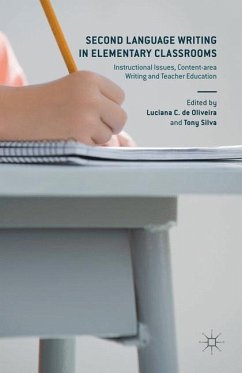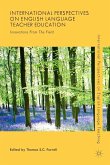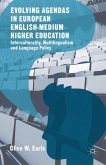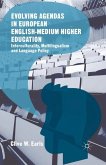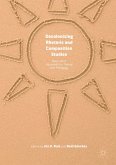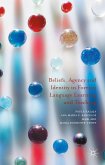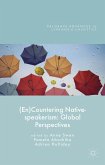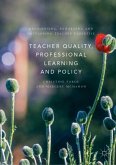Second Language Writing in Elementary Classrooms focuses on L2 writing in elementary classrooms. It features chapters that highlight research in elementary classrooms focused on the writing development of multilingual children, and research in teacher education to prepare elementary teachers to teach L2 writing and address L2 writers' needs.
Review 1 - Betsy Gililand, University of Hawaii Manoa
General
1) In your own words, please provide a short outline of the project
The book consists of chapters written by separate authors, each focused on an individual topic. The first section of 3 chapters covers 'Instructional Issues' that include an overview of the field of elementary L2 writing, a study of elementary students writing on digital platforms, and a discussion of co-teaching as an approach. The second section of 4 chapters addresses writing in the content areas, including 3 chapters about using systemic functional linguistics in science writing and one on storytelling in language arts. The final section of 3 chapters addresses issues of teacher preparation, including a vague description of teacher knowledge, a case study of one novice teacher's learning, and a survey study of in-service elementary teachers.
2) Of the different product categories outlined above, which do you feel this proposal best fits and why?
Edited collection: It is definitely a collection of work by various authors, but more a collection of research studies, not a definitive handbook. It is too long to be a 'pivot' volume, and not geared to students.
Proposal
3) Does this proposal offer a useful and/or original contribution to the field? Is it addressing any new/emerging areas?
It does, as there are (to my knowledge) no academic/research-based books focused on second language writing in elementary schools. The field of second language writing has only in the last decade recognized that it needs to expand its scope to K12 contexts, given its previous focus mainly on college age learners.
4) Does it adequately engage with recent scholarship? Does it take existing scholarship forward?
This is one place I feel like the editors' proposal does not do their subject justice. In discussing recent scholarship, they make the claim that the Journal of Second Language Writing has only published 3 articles in the last decade on elementary age learners in the US. They neglect to consider whether other journals have addressed this topic. A cursory search of the NCTE website shows quite a lot of journal articles that in some way address second language writing in elementary schools (perhaps these articles were not 100% focused on the topic, but it would still do to consider that writing may often be included in studies of reading and writing together, for example). There are quite a few other journals that the editors also did not mention where this kind of research may be more likely to appear-journals written with elementary school students, rather than second language writing, as the focus. The editors similarly do not mention research that has addressed elementary age students learning to write in other languages in other countries. Surely TESOL Quarterly and maybe even JSLW have published studies that could be useful to their argument for the book.
5) What are the strengths and weaknesses of the proposal? You may wish to consider structure, organisation, coherence and presentation of material; scope, coverage and breadth of appeal or degree of specialisation; whether there are any obvious omissions; timeliness and likely shelf-life of the research; what proportion of the work, if any, will require substantial re-working? Are any suggested improvements fundamental to the project's success or discretionary matters which might be addressed after the project has been accepted?
One thing I especially like about this book is that it considers both students and teacher practices. Given that there are relatively few studies on this topic as yet, it is helpful to pull together what is known about how young learners interact with writing and how their teachers learn to use writing with language learners. Most of the proposed chapters take a clear focus on one aspect of this topic in ways that complement the other chapters. (see my comments later in this section on chapters that do not
General
1) In your own words, please provide a short outline of the project
The book consists of chapters written by separate authors, each focused on an individual topic. The first section of 3 chapters covers 'Instructional Issues' that include an overview of the field of elementary L2 writing, a study of elementary students writing on digital platforms, and a discussion of co-teaching as an approach. The second section of 4 chapters addresses writing in the content areas, including 3 chapters about using systemic functional linguistics in science writing and one on storytelling in language arts. The final section of 3 chapters addresses issues of teacher preparation, including a vague description of teacher knowledge, a case study of one novice teacher's learning, and a survey study of in-service elementary teachers.
2) Of the different product categories outlined above, which do you feel this proposal best fits and why?
Edited collection: It is definitely a collection of work by various authors, but more a collection of research studies, not a definitive handbook. It is too long to be a 'pivot' volume, and not geared to students.
Proposal
3) Does this proposal offer a useful and/or original contribution to the field? Is it addressing any new/emerging areas?
It does, as there are (to my knowledge) no academic/research-based books focused on second language writing in elementary schools. The field of second language writing has only in the last decade recognized that it needs to expand its scope to K12 contexts, given its previous focus mainly on college age learners.
4) Does it adequately engage with recent scholarship? Does it take existing scholarship forward?
This is one place I feel like the editors' proposal does not do their subject justice. In discussing recent scholarship, they make the claim that the Journal of Second Language Writing has only published 3 articles in the last decade on elementary age learners in the US. They neglect to consider whether other journals have addressed this topic. A cursory search of the NCTE website shows quite a lot of journal articles that in some way address second language writing in elementary schools (perhaps these articles were not 100% focused on the topic, but it would still do to consider that writing may often be included in studies of reading and writing together, for example). There are quite a few other journals that the editors also did not mention where this kind of research may be more likely to appear-journals written with elementary school students, rather than second language writing, as the focus. The editors similarly do not mention research that has addressed elementary age students learning to write in other languages in other countries. Surely TESOL Quarterly and maybe even JSLW have published studies that could be useful to their argument for the book.
5) What are the strengths and weaknesses of the proposal? You may wish to consider structure, organisation, coherence and presentation of material; scope, coverage and breadth of appeal or degree of specialisation; whether there are any obvious omissions; timeliness and likely shelf-life of the research; what proportion of the work, if any, will require substantial re-working? Are any suggested improvements fundamental to the project's success or discretionary matters which might be addressed after the project has been accepted?
One thing I especially like about this book is that it considers both students and teacher practices. Given that there are relatively few studies on this topic as yet, it is helpful to pull together what is known about how young learners interact with writing and how their teachers learn to use writing with language learners. Most of the proposed chapters take a clear focus on one aspect of this topic in ways that complement the other chapters. (see my comments later in this section on chapters that do not

